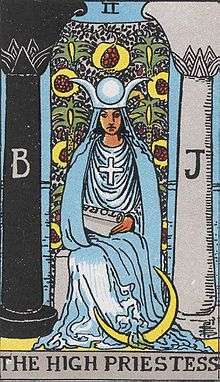Boaz and Jachin
According to the Bible, Boaz and Jachin were two copper, brass or bronze pillars which stood on the porch of Solomon's Temple, the first Temple in Jerusalem.[1] They are sometimes used as symbols in Freemasonry and Tarot.
Description

In the Bible
The pillars had a size nearly six feet (1.8 metres) thick and 27 feet (8.2 metres) tall. The eight-foot (2.4 metres) high brass chapiters, or capitals, on top of the columns bore decorations, in brass, of lilies. The original measurement as taken from the Torah was in cubits, which records that the pillars were 18 cubits high and 12 cubits around, and hollow—four fingers thick. (Jeremiah 52:21–22). Nets of checkerwork covered the bowl of each chapiter, decorated with rows of 200 pomegranates, wreathed with seven chains for each chapiter, and topped with lilies (1 Kings 7:13–22, 41–42).
The pillars did not survive the destruction of the First Temple; Jeremiah 52:17 reports: "The Chaldeans broke up the bronze columns of the House of the Lord". II Kings 25:13 has a similar account. The pillars were carried away in pieces for ease of transportation. When the Second Temple was built, they were not returned and there exists no record of new pillars being constructed to replace them.[2]
Josephus
According to the first-century Romano-Jewish scholar Josephus book Antiquities of the Jews, Boaz (Hebrew בֹּעַז boʿaz "In him/it [is] strength") stood on the left on the portico of Solomon's Temple, while Jachin (Hebrew יָכִין yakin "He/it will establish") stood on the right, and the two were made by an Israelite craftsman named Hiram.[3]
Contemporary use

The Romanesque Church of Santa Maria Maggiore at Tuscania, Italy, has a recessed entrance flanked by a pair of free-standing stone columns intended to evoke Boaz and Jachin.[4]
Columns representing Boaz and Jachin can be found in most Masonic Lodges, and are emblematic of their use in Masonic ritual.[5] The pillars are part of a symbolic use of Solomon's Temple itself.[6]
Jakin, an incorporated town in the southwest of the U.S. state of Georgia, takes its name from the pillar.[7]
Some variants of the Tarot card The High Priestess depict Boaz and Jachin.[8]
In fiction
- Russell Hoban's novel The Lion of Boaz-Jachin and Jachin-Boaz (1973) has two characters named after the pillars.[9]
- In The Lost Symbol (2009), a Robert Langdon novel by Dan Brown, the villain Mal'akh had tattooed Boaz and Jachin on his legs.[10]
- In the Da Vinci Code, the pillars are described as part of the Rosalyn Chapel
See also
References
- ↑ See (1 Kings 7:15, 1 Kings 7:21; 2 Kings 11:14; 23:3).
- ↑ "OzTorah » Blog Archive » Pillars of the Temple". www.oztorah.com. Retrieved 13 September 2018.
- ↑ Josephus, Flavius. "The Antiquities of the Jews". Project Guternberg. Retrieved July 8, 2015. Book 8, Chapter 3, Paragraph 4.
- ↑ Hamblin, William J. and Seeely, David Rolph, Solomon's Temple; Myth and History, Thames and Hudson, 2007, p. 109
- ↑ "PS Review of Freemasonry". PS Review of Freemasonry. Retrieved 13 September 2018.
- ↑ Moore, William D. (14 September 2018). "Masonic Temples: Freemasonry, Ritual Architecture, and Masculine Archetypes". Univ. of Tennessee Press. p. 16-17. Retrieved 14 September 2018 – via Google Books.
- ↑ Resolution on Jakin centennial, Georgia House of Representatives Archived 2008-05-21 at the Wayback Machine..
- ↑ Dean, Liz (15 May 2015). "The Ultimate Guide to Tarot: A Beginner's Guide to the Cards, Spreads, and Revealing the Mystery of the Tarot". Fair Winds Press. p. 39. Retrieved 13 September 2018 – via Google Books.
- ↑ (U.S.), Children's Literature Association; Literature, Modern Language Association Group on Children's (13 September 1980). "Children's literature, volume 8: annual of the Modern Language Association Division on Children's literature and the Children's Literature Association". Yale University Press. Retrieved 13 September 2018 – via Google Books.
- ↑ Cox, Simon (2014). Decoding The Lost Symbol: The Unauthorized Expert Guide to the Facts Behind the Fiction. Simon & Schuster. p. 28-29. ISBN 9781439172612.
External links
| Wikimedia Commons has media related to Boaz and Jachin. |
- Treasury of Scripture Knowledge Definition